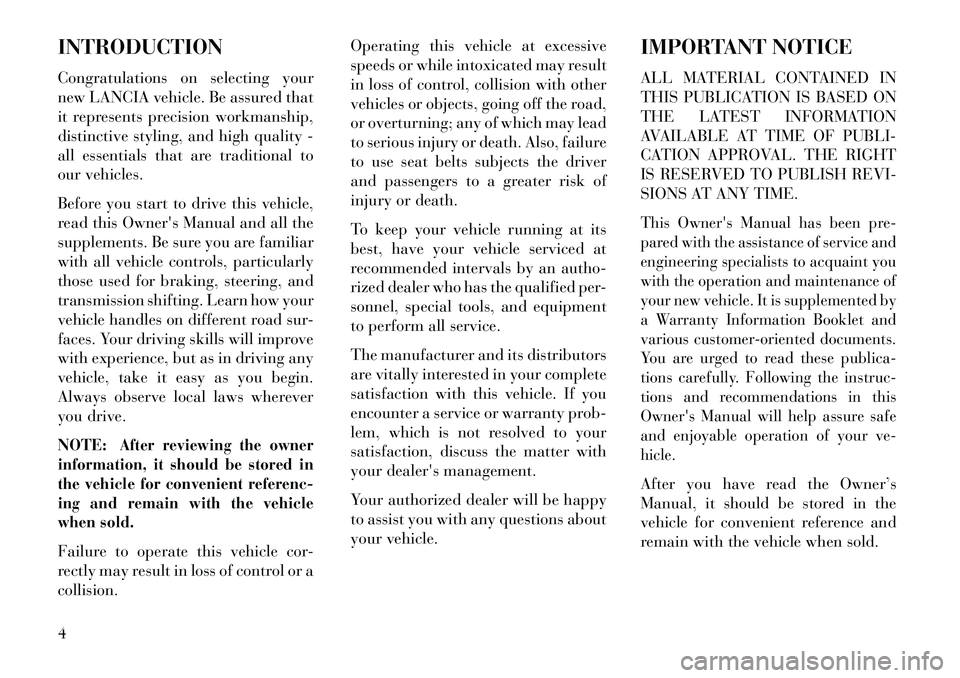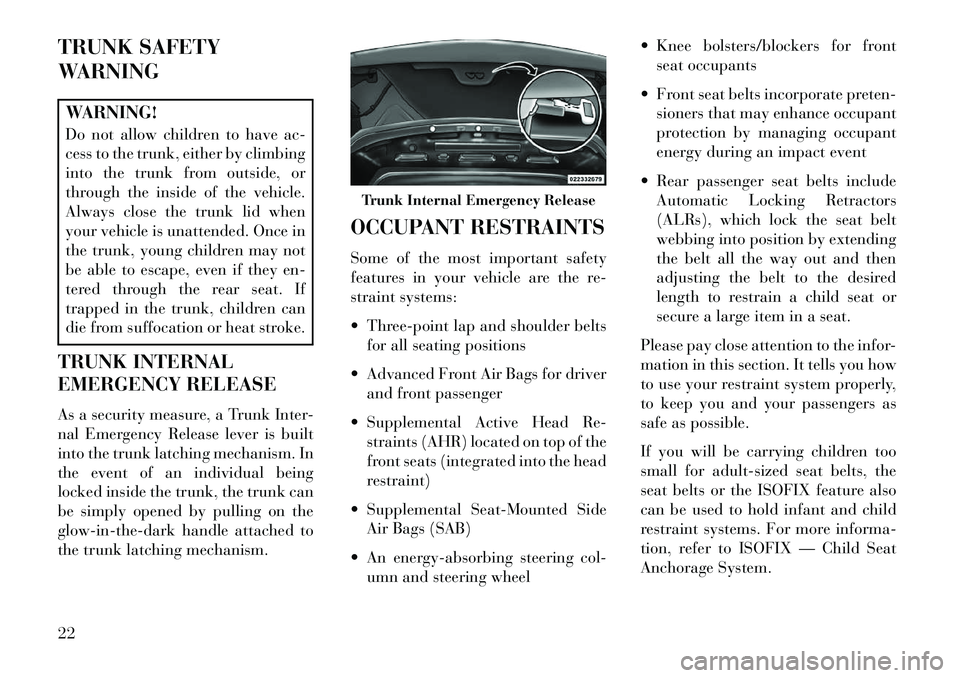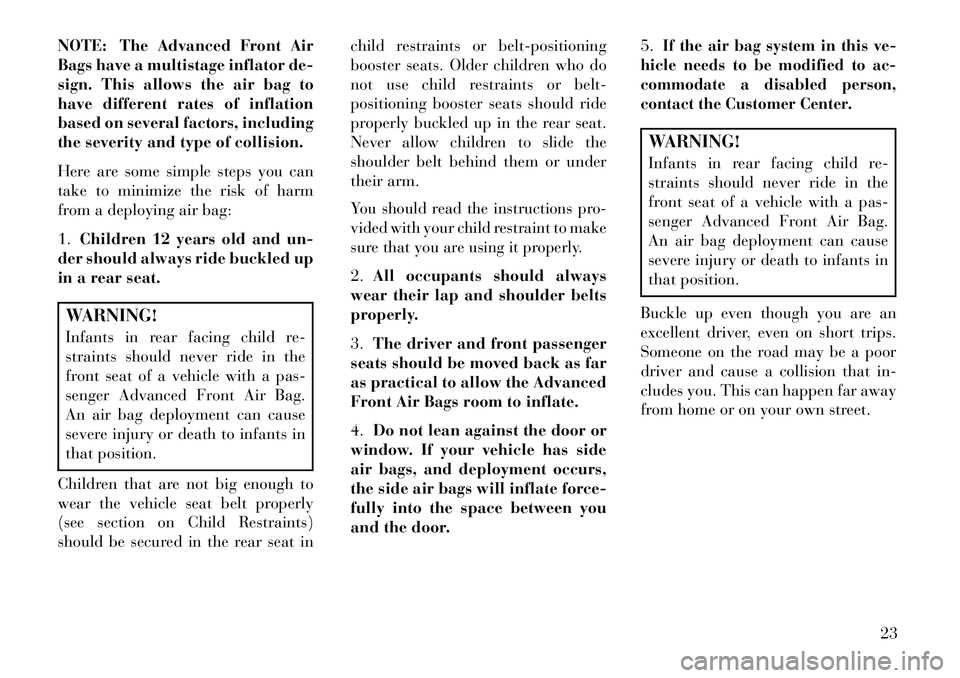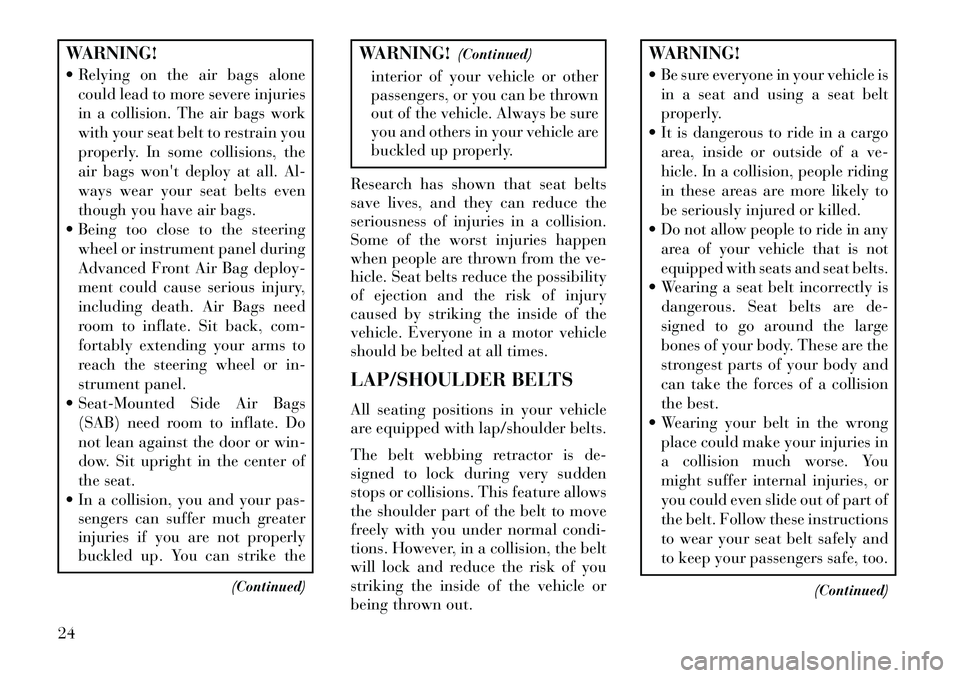belt Lancia Flavia 2013 Owner handbook (in English)
[x] Cancel search | Manufacturer: LANCIA, Model Year: 2013, Model line: Flavia, Model: Lancia Flavia 2013Pages: 244, PDF Size: 2.87 MB
Page 10 of 244

INTRODUCTION
Congratulations on selecting your
new LANCIA vehicle. Be assured that
it represents precision workmanship,
distinctive styling, and high quality -
all essentials that are traditional to
our vehicles.
Before you start to drive this vehicle,
read this Owner's Manual and all the
supplements. Be sure you are familiar
with all vehicle controls, particularly
those used for braking, steering, and
transmission shifting. Learn how your
vehicle handles on different road sur-
faces. Your driving skills will improve
with experience, but as in driving any
vehicle, take it easy as you begin.
Always observe local laws wherever
you drive.
NOTE:
After reviewing the owner
information, it should be stored in
the vehicle for convenient referenc-
ing and remain with the vehicle
when sold.
Failure to operate this vehicle cor-
rectly may result in loss of control or a
collision. Operating this vehicle at excessive
speeds or while intoxicated may result
in loss of control, collision with other
vehicles or objects, going off the road,
or overturning; any of which may lead
to serious injury or death. Also, failure
to use seat belts subjects the driver
and passengers to a greater risk of
injury or death.
To keep your vehicle running at its
best, have your vehicle serviced at
recommended intervals by an autho-
rized dealer who has the qualified per-
sonnel, special tools, and equipment
to perform all service.
The manufacturer and its distributors
are vitally interested in your complete
satisfaction with this vehicle. If you
encounter a service or warranty prob-
lem, which is not resolved to your
satisfaction, discuss the matter with
your dealer's management.
Your authorized dealer will be happy
to assist you with any questions about
your vehicle.
IMPORTANT NOTICE
ALL MATERIAL CONTAINED IN
THIS PUBLICATION IS BASED ON
THE LATEST INFORMATION
AVAILABLE AT TIME OF PUBLI-
CATION APPROVAL. THE RIGHT
IS RESERVED TO PUBLISH REVI-
SIONS AT ANY TIME.
This Owner's Manual has been pre-
pared with the assistance of service and
engineering specialists to acquaint you
with the operation and maintenance of
your new vehicle. It is supplemented by
a Warranty Information Booklet and
various customer-oriented documents.
You are urged to read these publica-
tions carefully. Following the instruc-
tions and recommendations in this
Owner's Manual will help assure safe
and enjoyable operation of your ve-
hicle.After you have read the Owner’s
Manual, it should be stored in the
vehicle for convenient reference and
remain with the vehicle when sold.
4
Page 16 of 244

PROGRAMMING ADDITIONALTRANSMITTERS . . . . . . . . . . . . . . . . . . . . . . . .17
GENERAL INFORMATION . . . . . . . . . . . . . . . . .17
BATTERY REPLACEMENT . . . . . . . . . . . . . . . .18
DOOR LOCKS . . . . . . . . . . . . . . . . . . . . . . . . . . . .18
MANUAL DOOR LOCKS . . . . . . . . . . . . . . . . . . .18
POWER DOOR LOCKS . . . . . . . . . . . . . . . . . . .19
WINDOWS . . . . . . . . . . . . . . . . . . . . . . . . . . . . . .19
POWER WINDOWS . . . . . . . . . . . . . . . . . . . . . .19
WIND BUFFETING . . . . . . . . . . . . . . . . . . . . . .21
TRUNK LOCK AND RELEASE . . . . . . . . . . . . . . . .21
TRUNK SAFETY WARNING . . . . . . . . . . . . . . . . . .22
TRUNK INTERNAL EMERGENCY RELEASE . . .22
OCCUPANT RESTRAINTS . . . . . . . . . . . . . . . . . . .22
LAP/SHOULDER BELTS . . . . . . . . . . . . . . . . . .24
LAP/SHOULDER BELT UNTWISTINGPROCEDURE . . . . . . . . . . . . . . . . . . . . . . . . . . .26
SEAT BELTS IN PASSENGER SEATING POSITIONS . . . . . . . . . . . . . . . . . . . . . . . . . . . .27
AUTOMATIC LOCKING RETRACTOR MODE (ALR) . . . . . . . . . . . . . . . . . . . . . . . . . . .27
ENERGY MANAGEMENT FEATURE . . . . . . . . . .28
SEAT BELT PRETENSIONERS . . . . . . . . . . . . .28
SUPPLEMENTAL ACTIVE HEAD RESTRAINTS (AHR) . . . . . . . . . . . . . . . . . . . . . .28
ENHANCED SEAT BELT USE REMINDER SYSTEM (BeltAlert®) . . . . . . . . . . . . . . . . . . . .30
SEAT BELTS AND PREGNANT WOMEN . . . . . .31
10
Page 26 of 244

NOTE:
If a fluttering noise is heard fromthe rear seat belts while driving
with the windows down, safely
bring the vehicle to a stop and
buckle the rear seat belts over
the empty seats. This will keep
tension on the seat belts and re-
move the fluttering condition.WARNING!Never leave children in a vehicle,
with the keys in the ignition switch.
Occupants, particularly unattended
children, can become entrapped by
the windows while operating the
power window switches. Such en-
trapment may result in serious in-
jury or death.Smart Glass Feature
The door window will lower slightly if
the window is fully up when opening
the door. The window will return to its
full up position after closing the door.
This action allows the door to open
without resistance and prevents win-
dow and top seal damage. Auto Window Down
The front window controls on the
driver and passenger door trim panels
have an Auto-Down feature. These
switches are labeled AUTO to indicate
this capability. Push the window
switch past the first detent, release,
and the window will go down auto-
matically.To open the window part way, push
the window switch to the first detent
and release it when you want the win-
dow to stop.
To cancel the Auto-Down movement,
operate the switch either in the up or
down direction and release the switch.The power window switches will remain
active for up to 10 minutes after the
ignition switch is turned to the LOCK
position. Opening either door will can-
cel this feature. The time for this feature
is programmable. Refer to “Electronic
Vehicle Information Center (EVIC)/
Personal Settings (Customer-Program-
mable Features)” in “Understanding
Your Instrument Panel” for further in-
formation.
Reset Window Smart Glass
Feature for Opening/Closing the
Door
If the vehicle battery goes dead, the
window Smart Glass Feature for
opening and closing the door will be
disabled. To reactivate the window
Smart Glass Feature, perform the fol-
lowing steps after vehicle power is
restored.
1. Lower all four windows to the full
open position.
2. Press and hold the Power Top
Switch in the Close direction. Once
the Power Top becomes fully closed,
all four windows will start closing.
3. Continue to hold the Power Top
Switch an additional two seconds
after the windows are fully closed.
4. Push all the window switches
down firmly to open the windows
completely and continue to hold the
switch down for an additional two
seconds after the window is fully
open.
20
Page 28 of 244

TRUNK SAFETY
WARNINGWARNING!
Do not allow children to have ac-
cess to the trunk, either by climbing
into the trunk from outside, or
through the inside of the vehicle.
Always close the trunk lid when
your vehicle is unattended. Once in
the trunk, young children may not
be able to escape, even if they en-
tered through the rear seat. If
trapped in the trunk, children can
die from suffocation or heat stroke.
TRUNK INTERNAL
EMERGENCY RELEASE
As a security measure, a Trunk Inter-
nal Emergency Release lever is built
into the trunk latching mechanism. In
the event of an individual being
locked inside the trunk, the trunk can
be simply opened by pulling on the
glow-in-the-dark handle attached to
the trunk latching mechanism. OCCUPANT RESTRAINTS
Some of the most important safety
features in your vehicle are the re-
straint systems:
Three-point lap and shoulder belts
for all seating positions
Advanced Front Air Bags for driver and front passenger
Supplemental Active Head Re- straints (AHR) located on top of the
front seats (integrated into the head
restraint)
Supplemental Seat-Mounted Side Air Bags (SAB)
An energy-absorbing steering col- umn and steering wheel Knee bolsters/blockers for front
seat occupants
Front seat belts incorporate preten- sioners that may enhance occupant
protection by managing occupant
energy during an impact event
Rear passenger seat belts include Automatic Locking Retractors
(ALRs), which lock the seat belt
webbing into position by extending
the belt all the way out and then
adjusting the belt to the desired
length to restrain a child seat or
secure a large item in a seat.
Please pay close attention to the infor-
mation in this section. It tells you how
to use your restraint system properly,
to keep you and your passengers as
safe as possible.
If you will be carrying children too
small for adult-sized seat belts, the
seat belts or the ISOFIX feature also
can be used to hold infant and child
restraint systems. For more informa-
tion, refer to ISOFIX — Child Seat
Anchorage System.
Trunk Internal Emergency Release
22
Page 29 of 244

NOTE: The Advanced Front Air
Bags have a multistage inflator de-
sign. This allows the air bag to
have different rates of inflation
based on several factors, including
the severity and type of collision.
Here are some simple steps you can
take to minimize the risk of harm
from a deploying air bag:
1.Children 12 years old and un-
der should always ride buckled up
in a rear seat.WARNING!
Infants in rear facing child re-
straints should never ride in the
front seat of a vehicle with a pas-
senger Advanced Front Air Bag.
An air bag deployment can cause
severe injury or death to infants in
that position.
Children that are not big enough to
wear the vehicle seat belt properly
(see section on Child Restraints)
should be secured in the rear seat in child restraints or belt-positioning
booster seats. Older children who do
not use child restraints or belt-
positioning booster seats should ride
properly buckled up in the rear seat.
Never allow children to slide the
shoulder belt behind them or under
their arm.
You should read the instructions pro-
vided with your child restraint to make
sure that you are using it properly.2.
All occupants should always
wear their lap and shoulder belts
properly.
3. The driver and front passenger
seats should be moved back as far
as practical to allow the Advanced
Front Air Bags room to inflate.
4. Do not lean against the door or
window. If your vehicle has side
air bags, and deployment occurs,
the side air bags will inflate force-
fully into the space between you
and the door. 5.
If the air bag system in this ve-
hicle needs to be modified to ac-
commodate a disabled person,
contact the Customer Center.WARNING!
Infants in rear facing child re-
straints should never ride in the
front seat of a vehicle with a pas-
senger Advanced Front Air Bag.
An air bag deployment can cause
severe injury or death to infants in
that position.
Buckle up even though you are an
excellent driver, even on short trips.
Someone on the road may be a poor
driver and cause a collision that in-
cludes you. This can happen far away
from home or on your own street.
23
Page 30 of 244

WARNING!
Relying on the air bags alonecould lead to more severe injuries
in a collision. The air bags work
with your seat belt to restrain you
properly. In some collisions, the
air bags won't deploy at all. Al-
ways wear your seat belts even
though you have air bags.
Being too close to the steering wheel or instrument panel during
Advanced Front Air Bag deploy-
ment could cause serious injury,
including death. Air Bags need
room to inflate. Sit back, com-
fortably extending your arms to
reach the steering wheel or in-
strument panel.
Seat-Mounted Side Air Bags (SAB) need room to inflate. Do
not lean against the door or win-
dow. Sit upright in the center of
the seat.
In a collision, you and your pas- sengers can suffer much greater
injuries if you are not properly
buckled up. You can strike the
(Continued)
WARNING!(Continued)
interior of your vehicle or other
passengers, or you can be thrown
out of the vehicle. Always be sure
you and others in your vehicle are
buckled up properly.
Research has shown that seat belts
save lives, and they can reduce the
seriousness of injuries in a collision.
Some of the worst injuries happen
when people are thrown from the ve-
hicle. Seat belts reduce the possibility
of ejection and the risk of injury
caused by striking the inside of the
vehicle. Everyone in a motor vehicle
should be belted at all times.
LAP/SHOULDER BELTS
All seating positions in your vehicle
are equipped with lap/shoulder belts.
The belt webbing retractor is de-
signed to lock during very sudden
stops or collisions. This feature allows
the shoulder part of the belt to move
freely with you under normal condi-
tions. However, in a collision, the belt
will lock and reduce the risk of you
striking the inside of the vehicle or
being thrown out.
WARNING!
Be sure everyone in your vehicle is in a seat and using a seat belt
properly.
It is dangerous to ride in a cargo area, inside or outside of a ve-
hicle. In a collision, people riding
in these areas are more likely to
be seriously injured or killed.
Do not allow people to ride in any
area of your vehicle that is not
equipped with seats and seat belts. Wearing a seat belt incorrectly is dangerous. Seat belts are de-
signed to go around the large
bones of your body. These are the
strongest parts of your body and
can take the forces of a collision
the best.
Wearing your belt in the wrong place could make your injuries in
a collision much worse. You
might suffer internal injuries, or
you could even slide out of part of
the belt. Follow these instructions
to wear your seat belt safely and
to keep your passengers safe, too.
(Continued)
24
Page 31 of 244

WARNING!(Continued)
Two people should never be belted into a single seat belt.
People belted together can crash
into one another in a collision,
hurting one another badly. Never
use a lap/shoulder belt or a lap
belt for more than one person, no
matter what their size.
Lap/Shoulder Belt Operating
Instructions
1.Enter the vehicle and close the door.
Sit back and adjust the front seat.
2. The seat belt latch plate is on the
outboard side of the front seat, next to
your arm. Grasp the latch plate and
pull out the belt. Slide the latch plate
up the webbing as far as necessary to
allow the belt to go around your lap. 3. When the belt is long enough to fit,
insert the latch plate into the buckle
until you hear a “click.”
WARNING!
A belt buckled into the wrong
buckle will not protect you prop-
erly. The lap portion could ride
too high on your body, possibly
(Continued)
WARNING!(Continued)
causing internal injuries. Always
buckle your belt into the buckle
nearest you.
A belt that is too loose will not protect you properly. In a sudden
stop you could move too far for-
ward, increasing the possibility of
injury. Wear your seat belt snugly.
A belt that is worn under your
arm is dangerous. Your body
could strike the inside surfaces of
the vehicle in a collision, increas-
ing head and neck injury. A belt
worn under the arm can cause
internal injuries. Ribs aren't as
strong as shoulder bones. Wear
the belt over your shoulder so that
your strongest bones will take the
force in a collision.
A shoulder belt placed behind you
will not protect you from injury
during a collision. You are more
likely to hit your head in a colli-
sion if you do not wear your shoul-
der belt. The lap and shoulder belt
are meant to be used together.
Pulling Out The Latch PlatePositioning The Lap Belt
25
Page 32 of 244

4. Position the lap belt across your
thighs, below your abdomen. To re-
move slack in the lap belt portion, pull
up on the shoulder belt. To loosen the
lap belt if it is too tight, lift up on the
shoulder belt and pull on the lap belt.
A snug belt reduces the risk of sliding
under the belt in a collision.WARNING!
A lap belt worn too high can in-
crease the risk of injury in a colli-
sion. The belt forces won't be at
the strong hip and pelvic bones,
but across your abdomen. Always
wear the lap part of your seat belt
as low as possible and keep it snug.
(Continued)
WARNING!(Continued)
A twisted belt may not protect you properly. In a collision, it
could even cut into you. Be sure
the belt is straight. If you can't
straighten a belt in your vehicle,
take it to your authorized dealer
immediately and have it fixed.
5. Position the shoulder belt on your
chest so that it is comfortable and not
resting on your neck. The retractor
will withdraw any slack in the belt.
6. To release the belt, push the red
button on the buckle. The belt will
automatically retract to its stowed po-
sition. If necessary, slide the latch
plate down the webbing to allow the
belt to retract fully. LAP/SHOULDER BELT
UNTWISTING PROCEDURE
Use the following procedure to un-
twist a twisted lap/shoulder belt.
1. Position the latch plate as close as
possible to the anchor point.
2. At about 15 to 30 cm above the
latch plate, grasp and twist the belt
webbing 180° to create a fold that
begins immediately above the latch
plate.
3. Slide the latch plate upward over
the folded webbing. The folded web-
bing must enter the slot at the top of
the latch plate.
4. Continue to slide the latch plate up
until it clears the folded webbing.
Inserting Latch Plate Into Buckle
26
Page 33 of 244

SEAT BELTS IN
PASSENGER SEATING
POSITIONS
The seat belts in the rear passenger
seating positions are equipped with
Automatic Locking Retractors (ALR)
which are used to secure a child re-
straint system. For additional infor-
mation, refer to “Installing Child Re-
straints Using The Vehicle Seat Belt”
under the “Child Restraints” section.
The chart below defines the type of
feature for each seating position.
Driver Cen-terPas-
senger
First
Row N/A N/A N/A
Second
Row ALR N/A ALR
N/A — Not Applicable
ALR — Automatic Locking Retractor
If the passenger seating position is
equipped with an ALR and is being
used for normal usage:
Only pull the belt webbing out far
enough to comfortably wrap around
the occupant's mid-section so as to
not activate the ALR. If the ALR is
activated, you will hear a ratcheting
sound as the belt retracts. Allow the
webbing to retract completely in this
case and then carefully pull out only
the amount of webbing necessary to
comfortably wrap around the occu-
pant's mid-section. Slide the latch
plate into the buckle until you hear a
"click."
AUTOMATIC LOCKING
RETRACTOR MODE (ALR)
In this mode, the shoulder belt is au-
tomatically pre-locked. The belt will
still retract to remove any slack in the
shoulder belt. The Automatic Locking
Mode is available on rear passenger-
seating positions with a combination
lap/shoulder belt. Use the Automatic
Locking Mode anytime a child safety seat is installed in a seating position
that has a belt with this feature. Chil-
dren 12 years old and under should
always be properly restrained in the
rear seat.
How To Engage The Automatic
Locking Mode
1. Buckle the combination lap and
shoulder belt.
2. Grasp the shoulder portion and
pull downward until the entire belt is
extracted.
3. Allow the belt to retract. As the
belt retracts, you will hear a clicking
sound. This indicates the safety belt is
now in the Automatic Locking Mode.
How To Disengage The Automatic
Locking Mode
Unbuckle the combination lap/
shoulder belt and allow it to retract
completely to disengage the Automatic
Locking Mode and activate the vehicle
sensitive (emergency) locking mode.
27
Page 34 of 244

WARNING!
The belt and retractor assemblymust be replaced if the seat belt
assembly Automatic Locking Re-
tractor (ALR) feature or any
other seat belt function is not
working properly when checked
according to the procedures in the
Service Manual.
Failure to replace the belt and retractor assembly could increase
the risk of injury in collisions.
ENERGY MANAGEMENT
FEATURE
This vehicle has a safety belt system
with an Energy Management feature
in the front seating positions to help
further reduce the risk of injury in the
event of a head-on collision. This
safety belt system has a retractor as-
sembly that is designed to release
webbing in a controlled manner. This
feature is designed to help reduce the
belt force acting on the occupant’s
chest. SEAT BELT
PRETENSIONERS
The seat belts for both front seating
positions are equipped with preten-
sioning devices that are designed to
remove slack from the seat belt in the
event of a collision. These devices may
improve the performance of the seat
belt by assuring that the belt is tight
about the occupant early in a colli-
sion. Pretensioners work for all size
occupants, including those in child
restraints.
NOTE: These devices are not a
substitute for proper seat belt
placement by the occupant. The
seat belt still must be worn snugly
and positioned properly.
The pretensioners are triggered by the
Occupant Restraint Controller
(ORC). Like the air bags, the preten-
sioners are single use items. A de-
ployed pretensioner or a deployed air
bag must be replaced immediately.
SUPPLEMENTAL ACTIVE
HEAD RESTRAINTS (AHR)
These head restraints are passive, de-
ployable components, and vehicles
with this equipment cannot be readily
identified by any markings, only
through visual inspection of the head
restraint. The head restraint will be
split in two halves, with the front half
being soft foam and trim, the back
half being decorative plastic.
How The Active Head Restraints
(AHR) Work
The Occupant Restraint Controller
(ORC) determines whether the sever-
ity, or type of rear impact will require
the Active Head Restraints (AHR) to
deploy. If a rear impact requires de-
ployment, both the driver and front
passenger seat AHRs will be deployed.When AHRs deploy during a rear im-
pact, the front half of the head re-
straint extends forward to minimize
the gap between the back of the occu-
pant’s head and the AHR. This system
is designed to help prevent or reduce
28